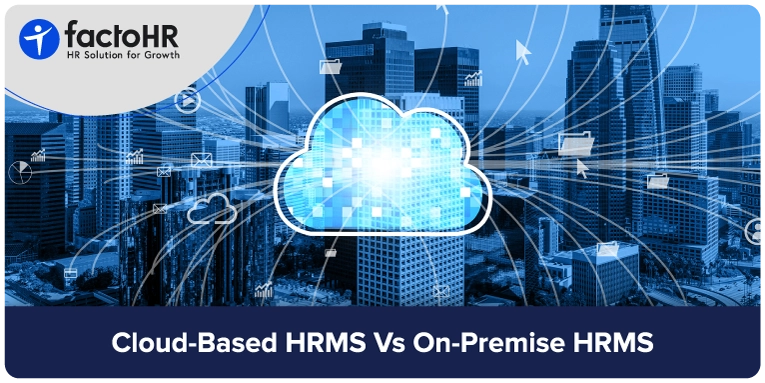Cloud-Based HRMS vs. On-Premise HRMS

Table of Contents
The modern world is experiencing a shift towards commoditization. Organizations expect technology solutions, including HR management, to play a significant role in their functioning. Human Resource Management Systems (HRMS) have become essential tools for firms. The HR management system market offers two main options: solutions and services such as our Cloud-Based HRMS and On-Premise HRMS.
Cloud-based HRMS is an HR software system managed and centralized from an offsite server. To use it, one has to sign in using an Internet browser. Unlike cloud-based HRMS, the on-premise system is hosted in the organization’s infrastructure, delivering control and customization to firms. However, it simultaneously entails high initial costs and regular servicing. In this blog, you will learn about Cloud-Based and On-Premise HRMS.
What Is A Cloud-Based HRMS?
A cloud-based HR system is an operation and system HRM type hosted on a remote server by a third party. Cloud-powered remote servers help businesses manage HR tasks like payroll, records, and recruitment. Internet technologies provide these tasks flexibility, open systems, and security. They offer these benefits at a reasonable cost.
As per a survey report by Deloitte, 90% of users agree that using cloud HR systems is helpful for the future and acts as force multipliers in an organization.
However, the Cloud-Based HRMS requires a subscription. Businesses should choose the HRMS that best meets their needs. Let’s look at the prerequisites for an on-premise solution.

What Is On-Premise HRMS?
These solutions are hosted on a company’s servers, so the infrastructure has its demands. The software and hardware need to be regularly upgraded. The system is generally managed by the company’s HR department, which owns it.
Advantages of Cloud-based HRMS
Accessibility
It can be accessed from anywhere and at any time as long as there is an internet connection. This remote accessibility enables employees and managers to perform various HR-related activities.
Adaptability
The number of users can be increased or decreased depending on the growth or shrinkage of the firm’s workforce. This flexibility ensures that firms restrict their use of IT resources.
Scalability
It is readily expandable to meet rising HR requirements, making it appropriate for enterprises of all sizes.
Security
The service provider is responsible for data security. Such measures can provide strong security but may pose privacy and control problems.
Cost-Effectiveness
It eliminates expensive initial costs in terms of purchasing servers and licenses. However, customers must subscribe to the application before using it. This subscription typically comes at a fee, often based on the selected package.
Automated Updates
These services manage the software and its updates and maintenance. This ensures the latest features and security patches when needed.

Disadvantages of Cloud-Based HRMS
Internet Dependency
These solutions are significantly reliant on a consistent and fast internet connection. Any delays or connectivity issues can limit access to HR applications. These delays affect productivity and operations.
Data Security Concerns
Cloud service providers use strong security procedures. However, some firms are still wary of storing sensitive employee data on third-party servers. They worry about data breaches and privacy issues.
Customization
Some HR systems may not be suitable when an organization needs complex software. These systems might not fit all business’s needs.
Integration Challenges
Integrating these systems with current on-premises or legacy applications can be difficult. It may require additional tools or adjustments. This can make the implementation expensive and challenging.
Advantages of On-Premise HRMS
Data Control and Privacy
It gives the organization exclusive control over its data. This ensures compatibility with governing rules and reduces data protection concerns.
Modification Flexibility
These solutions offer greater customization and interaction with current systems. They allow enterprises to modify the software to meet their exact needs.
Connectivity With Legacy Systems
These HR management systems easily interface with legacy systems and other business applications.
Offline Availability
Most HR applications can also be used offline, meaning business continuity.
Significant Cost Savings (Long-Term)
Despite the high cost of on-premises systems, firms can avoid ongoing costs. This is possible with cloud solutions.

Disadvantages of On-Premise HRMS
High Initial Expenses
Procuring these HR systems often requires a large hardware, software, and installation investment. This can be challenging for SMEs.
Installment Issues
The installation of the software may take time and effort. Sometimes, the system may not even support it.
Maintenance and Updates
It involves keeping and updating software. Data backup and security can be costly and time-consuming for organizations.
Scalability Constraints
These systems may have limited scalability. Adding more users or expanding functionality often requires extra hardware and software investments. This can make it hard to keep up with rapid business growth or changing needs.
Accessibility Constraints
This system is often only accessible at the organization’s facilities or through a secure remote connection. This can limit employee efficiency and teamwork when working remotely.
While cloud HRMS offers flexibility and lower setup costs, businesses can review a detailed list of top HRMS software providers in India to choose the right deployment model.
Difference Between Cloud-Based HRMS and On-Premise HRMS
Cloud-based HRMS and On-Premise HRMS are two of the most popular options in India. To choose between the two, identify the factors defining each solution and determine which suits the firm.
Business Size
Assess the size of your firm. A growing firm with more than a cloud-based solution can find better options. An on-premise solution may be ideal in such situations.
Upgrades and Fixes
An on-premises system requires manually searching for new patches and paying additional fees for updates. In contrast, cloud-based HRMS does not require manual labor and is often free of charge.
Data Backup
While on-premise HR management allows you to manage your data, you are solely responsible for any data loss or security breach. On-cloud HR allows for easier data backup than on-premises servers.
Internet Usage
A cloud-based HR program would require constant internet connectivity. On-premise systems can be installed and used offline.
Flexibility
Cloud HRMS allows for a monthly contract, so there’s no need to purchase it if unused. An on-premise management system requires payment for additional software and hardware.
Capital Investment
In the case of an on-premise HR solution, the money you spend is often capitalized and its value depreciated. In contrast, with an on-cloud HR solution, you can use it online and may change it whenever you want.
Cost Differences
Although cloud-based systems may have a lower initial cost, on-premises solutions can be more cost-effective in the long run. They often outperform cloud-based systems in terms of long-term ownership costs.

Key Comparisons For Choosing Cloud-Based HRMS Or On-Premise HRMS
Cost
Recurring subscriptions are a significant advantage of cloud HRM. On-premise requires upfront hardware and software setup expenditures and considerable planning, configuration, and implementation costs. As a result, cloud-based HRMS typically has cheaper entry costs. Cloud system subscription fees can increase over time, making the total cost higher than on-premise HRM.
Data Security
An on-premises solution offers strong data security and control. All critical data is protected behind a firewall. However, if managing sensitive data is a concern, a cloud-based system may be a better option for storing and securing it.
Scalability
Cloud HRMS may be scaled up or down as your organization expands. Expanding functionality is easy with this solution. It relies on the Internet and third-party servers. On-premise solutions may need some infrastructure improvements for scalability. To achieve longer-term scalability, you must increase your infrastructure investment.
IT Solutions
Updating and maintaining on-premise systems requires significant resources from the IT team. With cloud-based applications, the supplier handles maintenance and upgrades. This helps companies avoid extra costs for periodic maintenance.
Usage
With the right equipment and a skilled IT team, an in-house installation of an on-premise HRMS may be suitable. A cloud-based system requires good internet connectivity.
Compliance
Both systems are compliant with HR data reporting and data rules. Cloud providers may have dedicated compliance teams to ensure continuing conformance. They can address these difficulties faster than on-premise HRM solutions.
Maintenance
Cloud systems may be more intuitive and user-friendly. This shortens personnel training times. It also makes connection with existing systems easier and less invasive to implement.
An on-premise HRMS requires manual upgrades and maintenance by in-house IT staff. This can impact overall efficiency. A cloud-based system provider handles all upgrades and maintenance. This can reduce the burden on the company.
How to Choose Between On-Premise and Cloud-Based HRM?
The two forms of HRMS serve different purposes and have advantages and disadvantages. Examining their qualities is beneficial in choosing which will remain consistent with any business’s strategic HRM and requirements.
Cloud-HRMS can manage HR functions for enterprises of any size. It offers a subscription-based pricing plan. This means no large capital investment in infrastructure is needed. Additionally, Cloud-HRMS reduces the IT workload. The service provider handles system updates, maintenance, and security.
On-premise HRMS provides excellent control over your data, but it has several disadvantages. The system is hosted on the company’s servers, so scalability and access remain constrained. Only on-site staff or those connected via VPN can view it. Ongoing updates and repairs might also incur costs over time. Organizations have more control over system updates and security. This allows for customization to meet specific requirements.
Cloud HRMS is among the best solutions for this initiative. It will allow for effective worker management and monitoring of company operations.
Conclusion
Therefore, the final decision as to whether an organization is better off with an On-Premise HRMS or a Cloud HRMS will depend on the business’s needs. On-premise is reasonable when the firm desires to manage every aspect of the solution, and it can do so. Cloud-based systems may be more appropriate for firms that value scalability, flexibility, and low IT upkeep. Businesses must thoroughly consider all of their choices before arriving at a decision.
Consulting with HR professionals can provide valuable insights. Examining case studies from similar firms is also helpful. This information assists organizations in weighing the advantages and disadvantages of each method. Schedule a demo with factoHR today to learn more about these cloud-based HRMS.

FAQs
Is Cloud More Reliable Than On-Premises?
Cloud system security can be as important as on-site security. In some cases, it is more secure. Many companies worry that the cloud is less safe than local facilities.
Is Cloud More Sustainable Compared To On-Premises?
Comparing cloud vs on-premises sustainability. The cloud is more sustainable, thanks to economies of scale. Cloud workloads run in large, shared data centers. These centers use resources more efficiently than smaller facilities.
What Are A Few Kinds Of HRMS That Are More Customizable?
On-premise solutions provide additional customization choices but require IT skills to make changes. Cloud-based solutions offer some flexibility but may only meet specific requirements.
Which Is Less Expensive? On Which Model, Cloud Or On-Premise?
Cloud-based software offers significant advantages. It usually has lower costs compared to traditional systems. Instead of paying a high upfront licensing fee, monthly payments are much lower.
Grow your business with factoHR today
Focus on the significant decision-making tasks, transfer all your common repetitive HR tasks to factoHR and see the things falling into their place.

© 2025 Copyright factoHR


